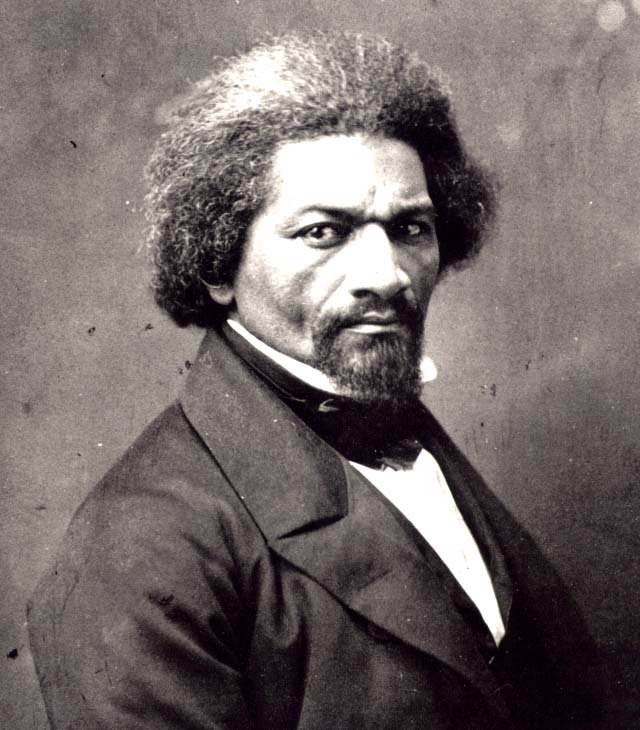Discuss Reflection Essays
Discuss WOW chapters 3 and 4
Douglass/ Response I/ Paragraphing
Assignment:
Read pages 84-85, 90-95 (“Road Trip”) and pages 103-113 in WOW Chapter 5
Reflection Essays: Save for Writing Workshop Ideas
Critical Reading
Response 1 is an exercise designed to develop your critical reading/thinking skills.
Critical reading (WOW pg. 65)
-
understanding the author's purpose
-
drawing inferences from the text
-
evaluating the evidence and logic of an author's assertions
-
extending ideas beyond the text
-
examining an author's bias
-
connecting ideas in one text to ideas in another text (synthesis)
What strategies can we use to be active readers?
How does Response 1 illustrate the characteristics of critical reading?

Response 1: Frederick Douglass
excerpt from Narrative of the Life of Frederick Douglass, An American Slave (pgs. 79-81)
Later in his narrative, Douglass writes, "I would at times feel that learning to read had been a curse rather than a blessing."
What does Douglass mean by this statement?
How is his view of reading shaped by the rhetorical situation in 1845?
Can you think of any modern-day situations or examples in which Douglass's view of reading is still valid, or is the ability to read and write (our access to knowledge and information) always a blessing?
Your response should be a carefully crafted paragraph in which you relate your position and draw on specific examples from the text in order to support it. Make sure that you respond to all aspects of the prompt.
Your response should be formal and typed double-spaced.
Volunteers to Share
-Kareem Abdul-Jabbar (Freakonomics pg. 161)
Narration as a Rhetorical Strategy (a rhetorical choice)
(page 73 in Handbook--uses "Patterns of Paragraph Development")
Narrative means storytelling.
- Some stories are fictional--they deal with characters and events that the writer has created from imagination.
- Some stories are nonfiction; they recreate events which happened to real people.
RHETORICAL STRATEGIES:
- For us, then, Rhetorical Strategies are the "means" Aristotle speaks of, the methods for "finding all the available arguments" (Bk. I, Ch.2) on a particular issue,
- those methods that allow us to convey most convincingly our point on a given topic.
- So, how is narration a rhetorical strategy?
- How does Douglass's narrative function as rhetoric? (as well as the slave narrative in general)
- Think about their purpose (the slave narrative=story)
- As a narrative (story) is Douglass's primary purpose to entertain?
- Other examples of narratives (fiction or non-fiction) that function as pieces of rhetoric?
- How do we use stories to persuade?
Think about how other genres of writing employ narrative strategies.
Other Common Rhetorical Strategies
(pages 73-78 in Handbook)
There are several rhetorical strategies you can use to make your writing more powerful. It is often a good idea to use several of these strategies in combination, although not every strategy will be applicable to every essay or topic you are discussing.
- Exemplification (74): Provide examples or cases in point. Are there examples - facts, statistics, cases in point, personal experiences, interview quotations - that you could add to help you achieve the purpose of your essay?
- Description (73): Detail sensory perceptions of a person, place, or thing. Does a person, place, or object play a prominent role in your essay? Would the tone, pacing, or overall purpose of your essay benefit from sensory details?
- Narration (73): Recount an event. Are you trying to report or recount an anecdote, an experience, or an event? Does any part of your essay include the telling of a story (either something that happened to you or to a person you include in your essay)?
- Process analysis(74): Explain how to do something or how something happens. Would any portion of your essay be more clear if you included concrete directions about a certain process? Are there any processes that readers would like to understand better? Are you evaluating any processes?
- Comparison and contrast (76): Discuss similarities and differences. Does your essay contain two or more related subjects? Are you evaluating or analyzing two or more people, places, processes, events, or things? Do you need to establish the similarities and differences between two or more elements?
- Division and classification (76): Divide a whole into parts or sort related items into categories. Are you trying to explain a broad and complicated subject? Would it benefit your essay to reduce this subject to more manageable parts to focus your discussion?
- Definition (77): Provide the meaning of terms you use. Who is your audience? Does your essay focus on any abstract, specialized, or new terms that need further explanation so your readers understand your point? Does any important word in your essay have many meanings and need to be need to be clarified?
- Cause and effect analysis (75): Analyze why something happens and describe the consequences of a string of events. Are you examining past events or their outcomes? Is your purpose to inform, speculate, or argue about why an identifiable fact happens the way it does?
- Argumentation: Convince others through reasoning. Are you trying to explain aspects of a particular subject, and are you trying to advocate a specific opinion on this subject or issue in your essay?
Paragraphs
WOW Ch. 3/ Handbook Ch. 5
-the basics (my notes)
Handbook pg. 64
Unity: a paragraph with unity develops one, and only one controlling idea. To ensure unity, edit out any stray ideas and do not go off topic with your writing.
Topic sentences state the main idea of the paragraph, and the other sentences in the paragraph support that idea.
Example:
pg. 65: Testing for Unity
- What is the topic sentence?
- How does this paragraph lack unity?
- How would you fix this paragraph?
Using Topic Sentences: (pg. 64/65 in handbook)
Placement
Writing Coherent Paragraphs (pg. 66)
A paragraph is coherent when all its sentences clearly relate to one another. You can create coherence by arranging details according to an organizing principle, by using transitional words and phrases, by using parallel structure, and by repeating key words and phrases.
1. Arranging Details (pg. 67)
spatial order
chronological order
logical order (fill in the gaps between ideas)
2. using Transitional words and phrases (pgs. 67-69)
3. using parallel structure
Parallelism: the use of matching words, phrases, clauses, or sentence structure to emphasize similar ideas
Where have we seen this tactic?
Paragraphs: A Test Case
Read to strengthen your writing
Pg. 79: Douglass
Paragraph 1: Introduction
- What is the topic sentence?
- How does it set up what is to come/set the structure of the essay?
In general, what do you want to accomplish in an introduction?
How do the conventions of introductions vary with genres?
Paragraph 2:
- First line: How does it transition?
- What is the topic of this paragraph?
- Why does Douglass discuss the role of Mistress Hugh before discussing the strategies? (arrangement)
Paragraph 3:
- First line: how does it transition from the previous paragraph?
- Why is this paragraph so short?
Paragraph 4:
- What is the topic?
- How is this paragraph unified?
- How is this a well-developed paragraph? (pg. 72 in Handbook)
Paragraphing Practice

Exercise: Determining the direction
of your paragraph
Topic: Setting up a first apartment
Determining direction: What about setting up a first apartment?
Initial topic sentence:
Setting up a first apartment can be quite a challenge.
What is the problem with a topic sentence like this?
How can we fine tune this?
What would we include in this paragraph?
How could we expand this topic into multiple paragraphs (an essay)?
What rhetorical strategies could we use? (handbook pages 73-78)
Comments (0)
You don't have permission to comment on this page.